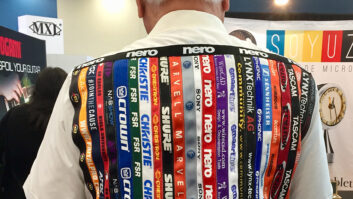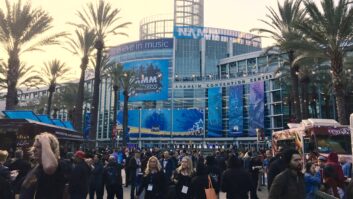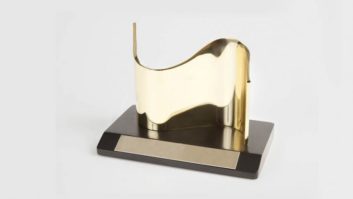
Don Was
Photo: Gabi Porter
The NAMM Foundation in Carlsbad, Calif., presents the 31st annual NAMM Technical Excellence & Creativity Awards and the NAMM TECnology Hall of Fame on January 23 at the 2016 NAMM Show. The events honor the best in audio and sound production as well as audio technology products from the last 75 years that have made a substantial impact.
Record producer and music industry executive Don Was will receive the 2016 Les Paul Award, an annual recognition of those who embody the creative spirit and legacy of one of the most revered musical geniuses who ever lived. Saturday night’s NAMM TEC Awards will be hosted by comedian Sinbad.
The January 23 event will be held in the Hilton Anaheim Pacific Ballroom. A reception begins at 6 p.m. with the ceremony following at 7 p.m.
Was is one of music’s most significant artists, producers and executives. He co-founded former Detroit-based band Was (Not Was) with childhood friend David Was (Weiss) before going on to produce decades of commercially successful and critically-acclaimed recordings for top artists.
He has earned multiple Grammy Awards for his production work over the past three decades including Bonnie Raitt’s Nick Of Time (1989), Producer Of The Year for work with artists ranging from The Rolling Stones to Willie Nelson and Roy Orbison (1994) and Ziggy Marley’s Best Musical Album For Children, Family Time (2009).
As President of Blue Note Records, Was oversees the label’s extensive reissue campaigns that serve audiences in both the analogue and digital realms. He joins a prestigious group of Les Paul honorees including Stevie Wonder, Sting, Pete Townshend and more, who have “set the highest standards of excellence in the creative application of audio and music technology,” according to the Les Paul Foundation.
Earlier on Saturday, the NAMM TECnology Hall of Fame will induct 10 audio products and innovations released between 1928 and 2002 that have made a significant contribution to the advancement of audio technology. The ceremony, presented by the NAMM Museum of Making Music and hosted by George Petersen, editor of Front of House Magazine, will be a celebration of nostalgia and innovation. A panel of more than 50 recognized audio experts, including authors, educators, engineers, facility owners and other professionals, selected the nominees.
The TECnology Hall of Fame ceremony will be presented Saturday, January 23, from 4 to 6 p.m. in room 202A of the Anaheim Convention Center in the TEC Tracks educational area. Seating is limited and available to credentialed NAMM attendees, inductees and their guests.
2016 NAMM TECnology Hall of Fame Inductees

1928: The Decibel Unit, Bell Laboratories
Today, we all so familiar with the decibel (dB) unit, whether dealing with electro-acoustical measurements on audio meters or with numbers that define Sound Pressure Levels, such as knowing that an SPL of 120 dB refers to the human hearing threshold of pain, or that 1 dB is accepted as the smallest change of level that is generally perceptible to the human ear. But the dB story starts back in 1923, the “mile of standard cable” unit of measurement (referring to the efficiency of telephone lines over distance) was replaced by term “Transmission Unit or TU,” based on a logarithmic scale that was one-tenth of a “bel,” named for Alexander Graham Bell. In 1928, Bell Labs’ transmission research director Ralph V. Hartley announced that Bell Labs was proposed changing the TU unit to “decibel” — meaning one-tenth of a Bel. And the dB is still with us nearly 90 years later.

1954: Wurlitzer Electronic Piano
Invented in 1954 by the Rudolph Wurlitzer Company’s chief design engineer Cliff Anderson, the Wurlitzer Electronic Piano was intended as a portable and compact replacement for the acoustical piano. It’s electromechanical design was based on a series of a tuned metal “reeds” with an electrical potential that when struck by a key, vibrated near a conductive member, changing a voltage shift that could be amplified and converted into audio oscillations. Although a “Wurly’s” sound hardly resembled an acoustic piano, it was portable and did have a distinctive voicing that soon became a mainstay of rock, pop and jazz artists worldwide, with some notable examples being Supertramp’s “The Logical Song” and Steely Dan’s “Do It Again.” The Wurlitzer Electronic Piano was in production from 1954 to 1984, and lives on today as valuable vintage instruments and digitally sampled re-creations.

1958: Auratone Sound Cubes
The original compact reference monitor, Auratone speakers were the brainchild of company founder Jack Wilson, who in 1958, debuted small cube-shaped studio monitors with a single 4.5-inch driver. While not exactly hi-fi, Auratone Sound Cubes offered a real-world representation of how your mix would sound on AM car radios or a mono TV set, and by the 1970’s, were found in every recording studio worldwide. As TV and auto sound improved, these eventually fell out of favor, as the Yamaha NS-10 became the standard in small reference monitors. Today with the popularity of music playbacks on iPads, smartphones and computer speakers, Auratone Sound Cubes returned in 2015, this time by Wilson’s grandson and other family members, and these lo-fi wonders are back in action to a new generation of studio users.

1966: Neumann KM84
The KM84 condenser microphone is not only is famed for its historic 28-year production run, but also was the first microphone to use the now-standard 48-volt phantom powering system invented by Georg Neumann. This “no visible power supply” approach, combined with the precision cardioid pattern of its KM64 capsule, low-noise FET electronics, -10 dB pre-attenuation switch (for 130 dB SPL handling) and ultra-compact 110mm body made this an instant hit with live, studio and broadcast engineers everywhere. In 1994, the KM84 was replaced with the KM184, which offered lower noise performance and greater SPL (138 dB) handling.

1966: Shure SM58
For five decades, the Shure SM58 has been a world standard in handheld vocal performance microphones. The story of the SM58 goes back to 1961, when Shure engineer Ernie Seeler developed the Unidyne III cardioid capsule, based on a new diaphragm design that offered uniform deflection characteristics over a wide frequency range without “break-up.” After three years of hard work and hundreds of tests involving dropping, throwing, cooking, salt spray immersion and submersion, the SM Series was born, and Seeler’s same capsule design was first employed for 1965’s SM57 and later with the SM58, with the chief difference between the two mics being the ball-shaped pop windscreen. Ironically, Seeler (a classical music fan who hated rock ‘n’ roll) created two of the mics that 50 years later, remain a mainstay of rock music.

1973: Roland RE-201 Space Echo
The Roland RE-201 Space Echo was hardly the first tape loop-based delay device, but added sophisticated controls — such as variable tape speeds, three-input mixer, 12 mode settings and a built-in spring reverb — that took it beyond the competition. It was developed by Ikutaro Kakehashi, whose Ace Tone company created organs, rhythm machines and tape delays, so it was no surprise he launched a line of delay and echo products (starting with simpler RE-100 and RE-200 units) when he founded Roland in 1972. But 1973’s RE-201 Space Echo offered a certain sound that soon became a favorite of artists of the time, including Bob Marley, David Bowie and Pink Floyd, and remains a staple in live performance and recorded tracks today, whether from vintage originals or in plug-in form.

1980: Lexicon PCM 41 Digital Delay
By modern standards, the Lexicon PCM 41 didn’t offer a lot of delay capability — 800 ms at the extended 6 kHz mode, or 200 ms at its 16 kHz “full bandwidth” setting. However, its great sound and versatile feature set took it well beyond that found on the typical digital delay. Certainly, it could handle basic chores such as speaker delays in P.A. systems. However, added touches such as input/delay mixing with recirculation (feedback), switchable polarity inversion of the feedback and delay signals, high/low pass filters and a full-on VCO section made it popular with studios, live mixers and musicians, for creating effects ranging from echo, double tracking, vibrato, phasing, flanging, resonant vocal sounds and more.

1988: Eventide’s H3000 UltraHarmonizer
Eventide’s H3000 UltraHarmonizer series took its original 1975 H910 and (1982) H969 Harmonizer pitch shifters to new heights, offering the first processor with human-like, intelligent/diatonic pitch shifting. But it didn’t stop there. Later incarnations of the H3000 ranged from the H3000B “broadcast” model (that even included helicopter sounds to simulate an in-air traffic report, even when the reporter was in an office) to the D/SE version with instrumental presets by guitarist Steve Vai and studio effects from top mix engineer Bob Clearmountain. And original H3000 users weren’t left out of the fun, as Eventide offered ROM upgrades and a sampling board option to keep earlier units up to date. Although discontinued in 2000, the H3000 UltraHarmonizers are still in demand in music, studio and live applications.

1998: Manley VoxBox
Conceptualized by Eveanna Manley, VoxBox is a no-compromise unit combining a mic preamp, compressor, equalizer and de-esser in a single chassis. But the story goes much further. The tube preamp stage adds a high-Z DI input and high pass filters; the 3:1 compressor is an electro-optical circuit; the passive EQ is based on the Pultec MEQ-5, but expanded to 33 bands; and the de-esser is an LA2A-sounding opto peak 10:1 with a passive LC sidechain. Single-box vocal processors had been around for more than a decade when the Manley VoxBox debuted in 1998; however, there hasn’t been a unit like it since — and it remains in production.

2002: Avid Digidesign Pro Tools | HD
In development for years, Pro Tools | HD was hardly a secret due to numerous industry leaks; however, the real surprise came with its debut at Winter NAMM 2002, when it was revealed that the system supported 192 kHz recording for true high-def performance. Best of all, a Pro Tools | HD rig cost about the same as the earlier PT|24 MIX 888|24 systems, but was based on enhanced hardware for improved DSP, more extensive routing and I/O options and improved fidelity. Just add your Mac G5 — then billed as “the world’s fastest personal computer” — some new hardware (or older interfaces connected via Pro Tools | HD’s “legacy” ports) and you were on your way to a recording platform that’s still going strong today.
For more information, go to www.tecawards.org and www.tecawards.org/tecnology-hall-of-fame.
Purchase tickets for the 31st annual NAMM Technical Excellence & Creativity Awards.







